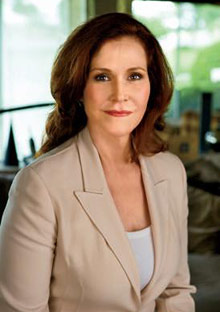The Skin Fixers: 6 Dermatologists Prescribe Solutions to Your Complexion Concerns
Your Problem: Wrinkles

Photo: Tammy Duvic
PAGE 2
Your Dermatologist: Mary Lupo, MD, New Orleans
"Dermatologists define wrinkles as lines that are visible even when your face is totally relaxed. For prevention and a slight correction of these etched-in creases, apply sunscreen in the morning and a prescription retinoid (an effective line-smoother) at night. The combination will improve the texture of the skin over several months. But deep wrinkles are caused in large part by a loss of volume in the tissue below the skin, which only injections of filler substances can restore. If you're open to fillers, I recommend either Radiesse or Sculptra. Radiesse is made of calcium-based beads that form a structure under the skin around which new collagen forms; it lasts up to 18 months. Sculptra is a form of synthetic lactic acid that triggers skin cells to make more collagen, and can last two years or a little more. Both need to be injected quite deeply, most often in the cheeks—volume loss in that area creates the deep wrinkles between the nose and the corners of the mouth. Hyaluronic acid fillers (like Restylane, Juvéderm, and Perlane) can also plump up deeper folds, but results last only about six months. If you're not ready for a big commitment, though, they're a good option. They're also the best choice for deeper lines around the mouth. (Sculptra and Radiesse can create bumps in that area.)
"To smooth more than just a few individual wrinkles, I would suggest a resurfacing laser. A nonablative version (in which the skin's surface is kept intact), like the Fraxel Re:store, involves about three days of downtime, and you need five to six treatments; I generally use it on patients under 50. If you're over 50 and your lines are quite deep, I recommend an ablative (meaning the skin's top layers are removed) resurfacing treatment, like Fraxel Re:pair or TotalFX. One treatment gives my patients in their 50s and 60s profound improvement of deep wrinkles. We can treat the whole face or—if the wrinkles are concentrated around the eyes or mouth and you have relatively fair, even-toned skin—we can spot-treat those areas. The treatments are painful, so we use a topical anesthetic, mild sedation, and nerve block injections (like what you'd get at the dentist). And expect a good week of downtime; I always show patients pictures of what their face will look like on day three—red, swollen, oozing—so they know what they're getting into. You'll see the full results after about six months (the treatment works by causing collagen to rebuild, which takes some time) and they should last several years."

Your Options:
"Dermatologists define wrinkles as lines that are visible even when your face is totally relaxed. For prevention and a slight correction of these etched-in creases, apply sunscreen in the morning and a prescription retinoid (an effective line-smoother) at night. The combination will improve the texture of the skin over several months. But deep wrinkles are caused in large part by a loss of volume in the tissue below the skin, which only injections of filler substances can restore. If you're open to fillers, I recommend either Radiesse or Sculptra. Radiesse is made of calcium-based beads that form a structure under the skin around which new collagen forms; it lasts up to 18 months. Sculptra is a form of synthetic lactic acid that triggers skin cells to make more collagen, and can last two years or a little more. Both need to be injected quite deeply, most often in the cheeks—volume loss in that area creates the deep wrinkles between the nose and the corners of the mouth. Hyaluronic acid fillers (like Restylane, Juvéderm, and Perlane) can also plump up deeper folds, but results last only about six months. If you're not ready for a big commitment, though, they're a good option. They're also the best choice for deeper lines around the mouth. (Sculptra and Radiesse can create bumps in that area.)
"To smooth more than just a few individual wrinkles, I would suggest a resurfacing laser. A nonablative version (in which the skin's surface is kept intact), like the Fraxel Re:store, involves about three days of downtime, and you need five to six treatments; I generally use it on patients under 50. If you're over 50 and your lines are quite deep, I recommend an ablative (meaning the skin's top layers are removed) resurfacing treatment, like Fraxel Re:pair or TotalFX. One treatment gives my patients in their 50s and 60s profound improvement of deep wrinkles. We can treat the whole face or—if the wrinkles are concentrated around the eyes or mouth and you have relatively fair, even-toned skin—we can spot-treat those areas. The treatments are painful, so we use a topical anesthetic, mild sedation, and nerve block injections (like what you'd get at the dentist). And expect a good week of downtime; I always show patients pictures of what their face will look like on day three—red, swollen, oozing—so they know what they're getting into. You'll see the full results after about six months (the treatment works by causing collagen to rebuild, which takes some time) and they should last several years."

Loss of volume in the tissue below the skin (not years of smiling) is largely the cause of deep wrinkles. Fillers can help plump them up.
Your Options:
- A.M.: Sunscreen (like Neutrogena Ultra Sheer Dry-Touch Sunblock SPF 55, $11)
- P.M.: Prescription retinoid, $40+
- Hyaluronic acid filler, every six months, $500 to $600
- Radiesse, every 18 months, $750; Sculptra, every two years, $1,000
- Five to six fractional nonablative laser treatments, every two to four weeks, $750 to $1,500 each
- One fractional ablative laser treatment, $1,500 to $8,000 (depending on size of area treated)



